![]()
Aroids and other genera in the Collection
Take the Tour Now?
Orchids
The
Exotic Rainforest
Monstera spruceana Engl.
%20Engl.%20photo%20by%20Joep%20copy.jpg)
Synonym: Monstera steyermarkii G.S. Bunting,
Basionym: Tornelia spruceana Schott
 Published to science in 1878
by German botanist Heinrich Gustav Adolf Engler (1844–1930), Monstera spruceana
has a wide distribution. The species is native to Bolivia, northern Brazil, Colombia,
Costa Rica, French Guyana, Guiana, Panama, Peru, Suriname and Venezuela.
Published to science in 1878
by German botanist Heinrich Gustav Adolf Engler (1844–1930), Monstera spruceana
has a wide distribution. The species is native to Bolivia, northern Brazil, Colombia,
Costa Rica, French Guyana, Guiana, Panama, Peru, Suriname and Venezuela.
Named in honor of English botanist Richard Spruce (1817-1873), M. spruceana is one of the few members of Monstera section Marcgraviopsis. According to some authors there may be two distinct species involved since the natural variation of the species is diverse. Monstera spruceana has been observed growing at elevations ranging from 70 to 1400 meters (230 to 4600 feet) above sea level.
The species was originally published in 1859 as Tornelia spruceana but science later determined the plant was published in the wrong genus and as a result the name T. spruceana is now a basionym. All species formerly in the genus Tornelia were transferred to the genus Monstera in 1866. A basionym is the first valid published name applied to a taxon which has been proven by later researchers to be an invalid name. Tornelia is now considered one of the four sections of the genus Monstera along with section Marcgraviopsis, section Echinospadix and section Monstera.
Monstera species as
well as all aroids are variable. Variability indicates the leaves
and some other features of a species do not always appear the same.
Natural variability in aroids is the source of confusion among collectors
that leads to a great deal of
bad information, especially on the internet.
Just because the leaves of a plant do not always appear the same does
not necessarily indicate a different species is involved. The
final determination must be made by comparing many features including
the arrangement of the venation (vein structure), the specific
characteristics of the petiole, the cataphyll, the
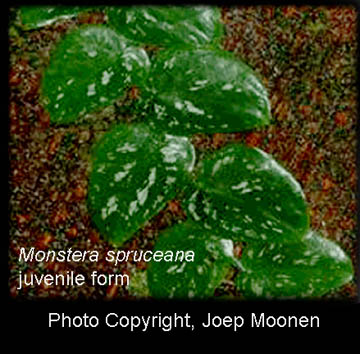 stem, root
system and the inflorescence.
stem, root
system and the inflorescence.
Once you complete this article you may wish to read this link for additional information on variation within aroid species.
All major botanical
gardens house a collection of dried herbarium specimens in order to
compare new material to a verified known specimen. A
herbarium sheet is considered the most positive method of determining if a
plant is a particular known species since the dried features are more prominent than on
a living specimen. Dried specimens of Monstera spruceana
have been confused by researchers with Monstera dilacerata and
Monstera subpinnata which are found in section Monstera.
In the adult stage a dried specimen can be confused due to the
similarity of some features but the differences are easily avoided
as long as the herbarium sheet
contains the dried leaf lamina along with the spadix and peduncle of the
inflorescence.
In addition to natural variability aroids undergo morphogenesis as they
grow. The morphogenic changes are known as a plant's ontogeny
while the changes in their shape is called heteroblasty. Ontogeny is the natural and progressive
changes made in any living organism as it grows. Collectors rarely understand the young plants they grow will
not remain in that form for its entire life, especially if allowed to
climb. Web forums sometimes have lengthy "discussions" over
which juvenile Monstera is a particular species
because the grower does not
understand how the ontogeny of an aroid causes change. As a result
some believe the
juvenile form of
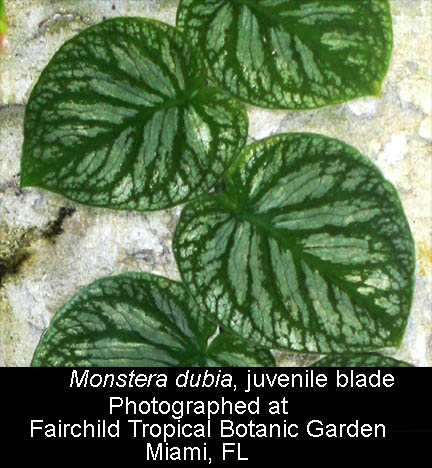 Monstera spruceana may be another species or
genus such as a Philodendron or a form of Monstera
dubia. As you can see from the photos on this page these species
look very little alike in the juvenile stage.
Monstera spruceana may be another species or
genus such as a Philodendron or a form of Monstera
dubia. As you can see from the photos on this page these species
look very little alike in the juvenile stage.
The morphogenesis of an aroid is similar to the changes observed in a human baby as it grows from a new born to an infant progressing to a toddler, a preschooler, an elementary age student and into the teenage years. As the child grows it morphs into a young adult before progressing into full adult maturity and she/he finally assumes the body common to the elderly stages of life. As a human matures it changes and so do aroids. It is rare for an older adult to meet a childhood acquaintance and immediately recognize them as an old friend thus it is equally difficult to recognize the juvnile form of most aroids.
Those progressive changes in the form and size of a plant are known as heteroblastic development, or the successive way leaves progressively change in both shape and size. Trying to identify an aroid by examining only a juvenile specimen is often impossible since we have no method of knowing the precise form it may take at any particular stage of its growth.
The juvenile form of Monstera spruceana begins its growth appressed. Appressed indicates the plant is pressed against the host. This form of heteroblasty is known as shingling. In the shingling growth form certain species of Monstera as well as other genera produce very short petioles causing their blades to be held flat against the host tree. As the plant climbs the over lapping blade sequence has an appearance similar to the shingles or tiles on a roof. Thus the name "shingle plants".
Monstera spruceana has been observed
growing a meter (3 feet) or more in the shingle form before beginning to change
to the pre-adult form. However, in some specimens the shingle stage does not grow
much
past the first few dozen leaves
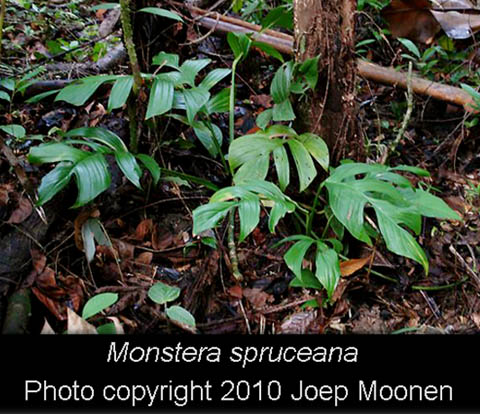 before beginning to change. Both the juvenile shingle stage as well as the first changes
into the adult form can be seen in the photos on this page. In the field notes of aroid
botanist Dr. Thomas B. Croat
Ph.D., P.A. Schulze Curator of Botany
of the Missouri
Botanical Garden in St. Louis, MO.
he notes having observed
variability in the juvenile
blades. The young blades may be either somewhat velvety and dark green or gray to plain
green as well as matte with dark green veins. The plain green form
is matte to semi-glossy on the underside while the
dark green form is somewhat velvety as well as glistening on the upper
surface. Juvenile plants may also have a darker band along margin
(edge) of major veins
before beginning to change. Both the juvenile shingle stage as well as the first changes
into the adult form can be seen in the photos on this page. In the field notes of aroid
botanist Dr. Thomas B. Croat
Ph.D., P.A. Schulze Curator of Botany
of the Missouri
Botanical Garden in St. Louis, MO.
he notes having observed
variability in the juvenile
blades. The young blades may be either somewhat velvety and dark green or gray to plain
green as well as matte with dark green veins. The plain green form
is matte to semi-glossy on the underside while the
dark green form is somewhat velvety as well as glistening on the upper
surface. Juvenile plants may also have a darker band along margin
(edge) of major veins
The species may grow as either an epiphyte or a hemiepiphyte. An epiphyte is a plant that does not have roots in the soil, but instead lives above the ground's surface supported by another plant, normally a tree. Epiphytes gather nutrients and water from the air or from organic debris from dead vegetation or from the droppings of rain forest animals.
Hemiepiphytes are divided into two forms with primary hemiepiphytes beginning as seeds in the droppings of a rain forest inhabitant that has eaten the berries of an aroid that germinate on the trunk or limbs of a tree in the same way an epiphyte forms. The primary hemiepiphyte then develops long roots that eventually reach the ground. In this way a hemiepiphyte attains height in the forest as quickly as possible to reach brighter light.
Secondary hemiepiphytes start their lives in the soil or on a tree trunk near the ground with grounded roots to gather additional nutrients but then then climbs the host where it morphs into the adult form, sometimes completely loosing the connection to the ground.
As the blades begin to morph they are oblong-ovate finally becoming divided into lobes. Upon occasion the host tree will fall as a result of fire or a storm requiring a specimen to become terrestrial until it can find a new host tree to climb. You can observe this precise event in some of Joep Moonen's photos of the species growing in French Guiana.
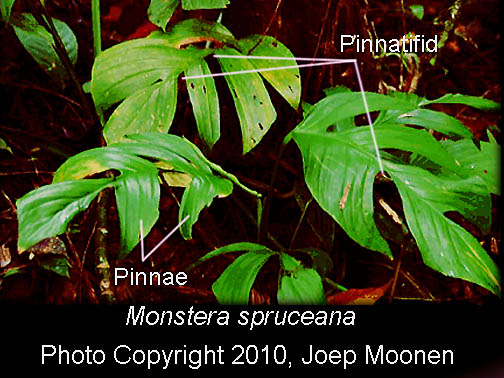 The
adult leaf blades of Monstera spruceana are bicolorous as well as
subcoriaceous (less than leathery) to moderately coriaceous (leathery)
with a weak glossiness to the blade's upper side (known as the
adaxial surface). Bicolorous means two colored;, i.e. medium green
with a dark green as the base on the adaxial side. Fully grown
blades may be a dull matte or weakly to semi-glossy but are slightly
paler in color as well as weakly glossy on the abaxial surface
(underside).
The
adult leaf blades of Monstera spruceana are bicolorous as well as
subcoriaceous (less than leathery) to moderately coriaceous (leathery)
with a weak glossiness to the blade's upper side (known as the
adaxial surface). Bicolorous means two colored;, i.e. medium green
with a dark green as the base on the adaxial side. Fully grown
blades may be a dull matte or weakly to semi-glossy but are slightly
paler in color as well as weakly glossy on the abaxial surface
(underside).
The major feature of an adult leaf of this species includes a pinnatifid leaf with broad pinnae. Pinnae means "feather" in Latin and describes a leaf that possesses leaflets arranged more or less in the form of a feather. Pinnatifid indicates a single leaf with divisions reaching almost to the midrib. Adult leaves typically measure 50 to 70 cm long by 25 to 40 cm wide but the size is also variable.
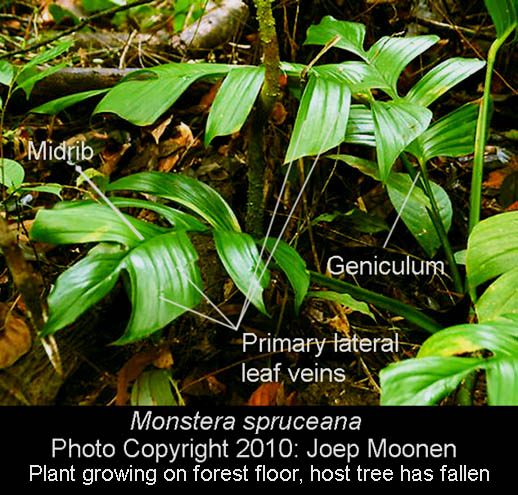 The midrib of the leaf is
either flattened, slightly sunken or sulcate above but narrowly raised and slightly paler in color on the underside.
Sulcate indicates a furrow or groove such as the depression sometimes
observed on the upper surface of a petiole commonly known as a C-shaped
depression.
The midrib of the leaf is
either flattened, slightly sunken or sulcate above but narrowly raised and slightly paler in color on the underside.
Sulcate indicates a furrow or groove such as the depression sometimes
observed on the upper surface of a petiole commonly known as a C-shaped
depression.
The midrib is the thick central vein which separates the two halves of the leaf while it mechanically supports the blade as well as being the means for the transportation of nutrients and water. The primary lateral leaf veins are convex and sometimes whitish below with the minor veins slightly obscure. The primaries are the veins that branch off the midrib and extend to the leaf margin (edges). There should be two to four primary lateral veins per pinna with four to ten pinnae per side. It is not uncommon for some leaves to be pinnatifid on only one side.
The stem of all plants is the base, central axis and main support which
is normally divided into nodes and internodes. The
nodes
are separated by the internodes that can produce a complete leaf or
roots from nodes that hold buds. The stem's roots then anchor the plant
either to the ground, a tree.
Although many collectors believe the stalk that supports the leaf is the
"stem", the support for a leaf blade is known as the petiole.
The petiole and leaf together are the complete leaf. The
petioles of Monstera spruceana are typically one-third to
two-thirds the length of the of the leaf lamina, The petioles are
normally a medium green while being
weakly glossy and
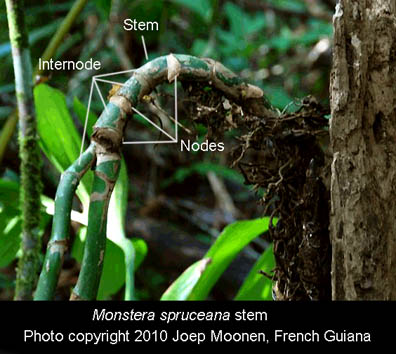 often speckled. The petiole possesses a
deciduous petiolar sheath that is curled inward.
Petiole sheaths are
extensions on each side of the petiole that are similar to "wings" that
may envelope the successive newly developing leaf
blade. The term
deciduous indicates the sheaths eventually fall from the plant.
often speckled. The petiole possesses a
deciduous petiolar sheath that is curled inward.
Petiole sheaths are
extensions on each side of the petiole that are similar to "wings" that
may envelope the successive newly developing leaf
blade. The term
deciduous indicates the sheaths eventually fall from the plant.
A slight to deeply sulcate geniculum can be observed at the tip (apex) of the petiole. A geniculum is a wrist-like organ always located at the apex of the petiole that allows a leaf to rotate and orient itself in order to control to some degree the sunlight it collects.
Even though collectors
commonly believe a Monstera is a form of Philodendron, the genera Monstera
and Philodendron are not one and the
same. There are several differences in Monstera species that
include the growth of holes known to science as fenestrations and the
presence of a geniculum which is commonly associated with plants in the
genus Anthurium. Monstera also have differences in the
sexual reproductive process.
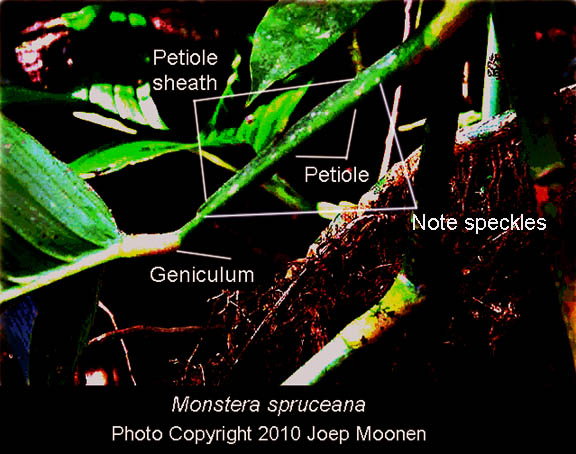 During sexual reproduction the inflorescence of Monstera spruceana produces a spathe
that is white surrounding a
spadix. The
inflorescence of Monstera species are bisexual and produce
perfect flowers that include both sexes within
a single flower while
Philodendron species produce unisexual flowers that have both male
and female flowers that grow separately. Both bisexual and
unisexual aroids produce blooms consisting of a simple leaf-like spathe
attached to the
During sexual reproduction the inflorescence of Monstera spruceana produces a spathe
that is white surrounding a
spadix. The
inflorescence of Monstera species are bisexual and produce
perfect flowers that include both sexes within
a single flower while
Philodendron species produce unisexual flowers that have both male
and female flowers that grow separately. Both bisexual and
unisexual aroids produce blooms consisting of a simple leaf-like spathe
attached to the
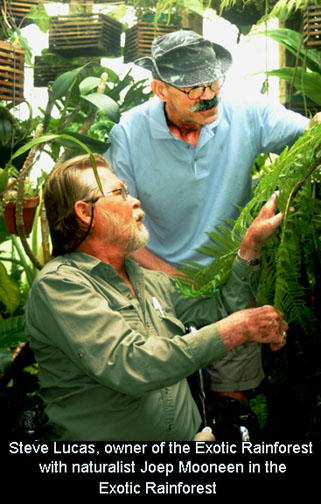 The female stigma
become receptive and ready for pollination
before the male pistals produce pollen in order to make it difficult
for the female portion of the flower to be pollinated by its own
pollen. Nature works
to insure pollination is achieved from another plant at male anthesis while
discouraging self-pollination in order to keep the species strong. Once the female flowers have completed anthesis the
male flowers begin to produce pollen that is normally taken to another
plant by an insect pollinator, normally a beetle from the genus
Cyclocephala.
The female stigma
become receptive and ready for pollination
before the male pistals produce pollen in order to make it difficult
for the female portion of the flower to be pollinated by its own
pollen. Nature works
to insure pollination is achieved from another plant at male anthesis while
discouraging self-pollination in order to keep the species strong. Once the female flowers have completed anthesis the
male flowers begin to produce pollen that is normally taken to another
plant by an insect pollinator, normally a beetle from the genus
Cyclocephala.To attract an insect pollinator an odor known as a pheromone that is attractive to very specific insects is produced by the sterile male flowers and released through a process known as thermogenesis. That pheromone is distributed by an increase in temperature within the spadix as a result of the release of salicylic acid and other natural occurring heat processes of the spadix. Shortly after this event occurs male anthesis initiates and pollen begins to be produced.
The inflorescence of Monstera spruceana is supported on a peduncle that is terete (round) and shorter than the spadix, The inflorescence is solitary and if pollinated the spadix begins to produce berries and then becomes known as an infructescence. A spadix which is producing fruit is white.
To learn more about natural
pollination within aroid species
refer to this link.
 The
scientific information in this article was extracted from the field
notes and published material of Dr. Tom Croat along with information
available on
CATE Araceae
My thanks to both Dr. Croat and to my friend Joep Moonen
for the use of their photographs.
The
scientific information in this article was extracted from the field
notes and published material of Dr. Tom Croat along with information
available on
CATE Araceae
My thanks to both Dr. Croat and to my friend Joep Moonen
for the use of their photographs.
For eco-tour information contact Joep Moonen at EmeraldJungleVillage@wanadoo.fr
Want to learn more
about aroids?
Join the
International Aroid Society:
http://www.exoticrainforest.com/Join%20IAS.html